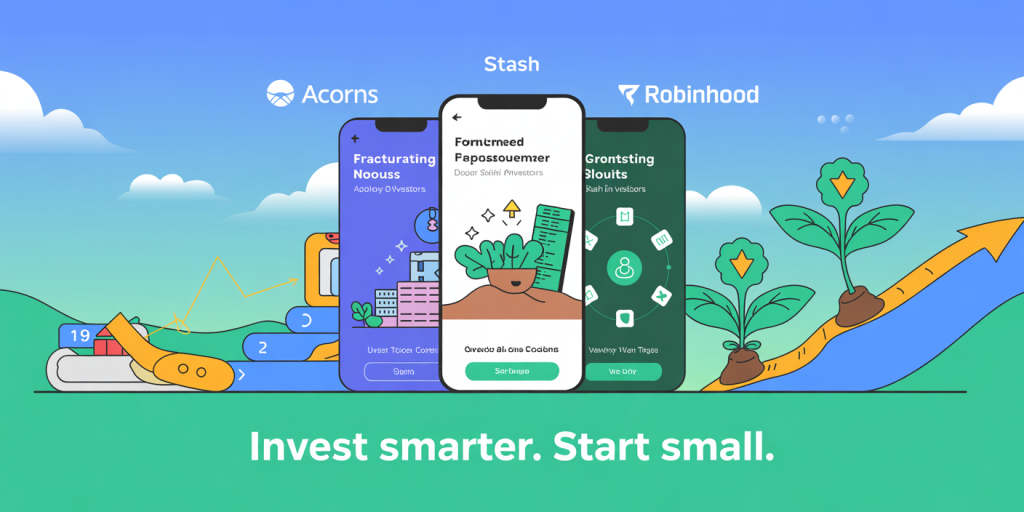Apps to Help You Invest Small Amounts Automatically
The journey of investing traditionally conjured images of hefty capital, complex spreadsheets, and professional brokers. However, the rise of fintech has democratized access to financial markets, allowing individuals to invest small amounts of money effortlessly. With the surge of mobile investment apps that automate the process, anyone can start building wealth, even with just a few dollars in their pocket. These apps not only simplify investing but also cultivate disciplined financial habits without overwhelming users with jargon or high fees.
Automated investment apps appeal especially to millennials and Gen Z, who prefer seamless digital experiences and seek ways to secure their financial futures without dedicating significant time or resources. As of 2023, research from Statista shows that nearly 45% of Millennials actively use Robo-advisor platforms or micro-investing apps. This trend highlights the growing appetite for automated wealth-building tools. The following sections explore some of the best automated investment apps designed to help small investors, including practical examples and data-driven comparisons to guide your decision-making.
Why Automated Micro-Investing Appeals to Small Investors
Micro-investing is an innovative concept where investors allocate minimal amounts of money into various investment portfolios through automated technology. This contrasts with traditional investing methods, which often require a substantial initial sum and manual oversight. The primary advantage for small investors is the ability to get started immediately with little financial risk.

One practical case is that of Sarah, a 27-year-old graphic designer who began using an automated investing app with just $5 weekly from her coffee budget. Over two years, despite fluctuations in the market, Sarah’s consistent contributions combined with automatic portfolio rebalancing earned her a 7.5% annual return, demonstrating the power of disciplined micro-investing.
Moreover, the digital automation ensures that contributions are continuous and periodic, reducing the likelihood of missing investment opportunities due to procrastination. According to a Vanguard study, automated investors tend to accumulate up to 30% more savings over a decade compared to manual investors because the system mitigates emotional biases around timing market entry or exit.
Top Apps for Automatic Small-Scale Investing
Several investment apps cater specifically to individuals who want to grow their wealth gradually and automatically. Each offers distinct features, fees, and strategies, suiting different investor preferences.
Acorns: Rounding Up Spare Change
Acorns is a popular app designed around the “round-up” concept, where everyday purchases made through linked debit or credit cards are rounded up to the nearest dollar. The difference is automatically transferred into a diversified portfolio. For example, if you buy a coffee for $3.45, Acorns rounds it up to $4.00 and invests the extra $0.55.
This micro-investing approach helps users save and invest without actively thinking about it. Acorns offers diversified portfolios built with ETFs (exchange-traded funds) and has multiple account options, including retirement and custodial accounts. As per their 2023 investor report, the average user contributes around $50 monthly through round-ups and recurring deposits.
Acorns charges a modest fee starting at $3 per month, making it affordable for small balances. The app also includes features like “Found Money,” which gives cashback from partner companies into the user’s investment account, amplifying growth opportunities.
Stash: Customization Meets Automation
Unlike purely automated round-up apps, Stash combines automation with investor education and control. Users can select fractional shares of stocks and ETFs based on thematic investing goals, such as sustainable companies or technology innovators, while also setting up automated weekly or monthly deposits.

For example, John, a 35-year-old teacher, uses Stash to invest automatically $25 every week focused on a portfolio that prioritizes ESG (Environmental, Social, Governance) criteria. This blend of automation and choice empowers actively engaged beginners. Stash charges $3 to $12 per month depending on the plan, which includes retirement accounts and stock-back rewards.
Stash reports a 40% user growth year-over-year, signaling increasing consumer appeal for apps that balance flexibility and automation in small-amount investing.
Robinhood: Commission-Free and User-Friendly
Robinhood revolutionized investment by eliminating commissions on trades, which traditionally ate into smaller returns. Although not a pure micro-investing app, Robinhood’s fractional share feature enables users to invest as little as $1 in blue-chip stocks or ETFs, making it highly accessible for small investors.
For instance, Emma, a university student, started investing on Robinhood with $10 divided across Tesla, Apple, and three ETFs. She uses the app’s recurring investment feature to automate deposits every two weeks. This method has helped her accumulate a diversified portfolio worth $3,000 in just under two years.
According to Robinhood’s 2022 data, over 31 million users have utilized fractional investing, which demonstrates the increasing trend of low-barrier investment platforms. The app’s real-time trading and simple interface provide extra advantages, although users should note it lacks automated portfolio management found in Robo-advisors.
Comparative Table of Automated Investing Apps for Small Amounts
| Feature | Acorns | Stash | Robinhood | Betterment | M1 Finance |
|---|---|---|---|---|---|
| Minimum Investment | $5 (round-ups) | $1 | $1 (fractional shares) | $0 | $100 |
| Fees | $3 – $5/mo | $3 – $12/mo | $0 | 0.25% AUM | $0 |
| Automated Deposits | Yes | Yes | Yes | Yes | Yes |
| Portfolio Management | Automated, ETF-based | Semi-automated, stocks & ETFs | Manual but offers fractional investing | Automated, goal-based | Automated, pie-based |
| Investment Options | ETFs | Stocks & ETFs | Stocks & ETFs | ETFs | Stocks & ETFs |
| Retirement Accounts | Yes | Yes | No | Yes | Yes |
| Ideal for | Beginners, passive savers | Beginners, hands-on investors | Small investors wanting commission-free trading | Hands-off investors | Investors wanting customization |
This table helps pinpoint which app aligns best with your investing style, cost sensitivity, and desired level of engagement.
Techniques Employed by Automated Investing Apps to Maximize Growth
Micro-investing apps adopt several strategies to optimize portfolio growth, minimize risk, and ensure regular contributions to combat volatility.
One widely used technique is Dollar-Cost Averaging (DCA), where small amounts are invested evenly over time regardless of market conditions. This approach reduces the impact of market timing and smooths out investment costs. Apps like Acorns and Stash promote DCA by automating weekly or monthly deposits, ensuring consistent entry points in the market.
Another method is portfolio diversification through ETFs, which spreads investment risk across many securities. For example, Acorns builds portfolios using global ETFs representing stocks, bonds, and real estate to offer balanced exposure. Such diversification is critical, especially for investors contributing small amounts, as it enhances risk-adjusted returns while minimizing loss potential.
Some apps, such as Betterment, implement automatic rebalancing where the portfolio is realigned periodically to maintain target allocations. This prevents drift caused by variable asset growth and secures intended risk levels without user intervention.
Real-World Impact: Small Investments Leading to Significant Returns
Small, consistent investments empowered by automation can accumulate significantly over time. Consider the hypothetical example of a person investing $25 weekly starting at age 25 into a diversified portfolio with a historical average annual return of 8%. By age 65, these investments potentially grow to over $250,000, demonstrating compound interest’s power.

Real-life testimonials abound: Josh, a 29-year-old software engineer, began using M1 Finance with $100 monthly contributions automated from his paycheck. Over four years, his portfolio tripled in value, while he appreciated the app’s flexibility to customize his “pie” of stocks and ETFs.
Studies reveal that people who automate savings and investing are 3 times more likely to reach their financial goals compared to those who rely on manual inputs. This behavioral advantage, combined with low entry barriers and transparent fees, makes automated micro-investment apps powerful tools for wealth-building across demographics.
Future Perspectives: The Evolution of Automated Small-Investment Platforms
The near future of automated micro-investing looks promising, buoyed by advances in AI, blockchain, and personalized finance. Emerging trends include increasingly tailored investment portfolios powered by machine learning algorithms that analyze individual behavior, risk tolerance, and market trends in real-time.
Furthermore, integrations with banking and payroll platforms will facilitate seamless saving-to-investment pipelines, removing any friction between income and investing. For instance, some apps are experimenting with instant round-ups and instant investing on transaction completions, shrinking the lag time and capturing more investment opportunities.
Regulatory changes are expected to increase protections and transparency, making it even easier for small investors to participate with confidence. Apps integrating cryptocurrencies as part of diversified portfolios are gaining traction, responding to evolving investor interests.
Education features powered by AI coaches will also guide investors through complex decisions, enhancing financial literacy along the automation journey. This synergy of technology and finance aims to close the wealth gap by engaging younger and more diverse investor communities previously excluded from traditional markets.
—
Automated investing apps for small amounts present an accessible, cost-effective gateway to the financial markets for beginners and seasoned investors alike. By leveraging the power of technology, they reduce barriers, provide disciplined saving mechanisms, and optimize growth through diversification and automation. As these platforms continue to evolve, their role in democratizing wealth creation will likely expand, enabling millions more to participate confidently in long-term investment strategies. Whether you prefer simple round-ups, curated stocks, or fully automated Robo-advisory services, there is an app designed to help every investor get started with small amounts and big ambitions.
